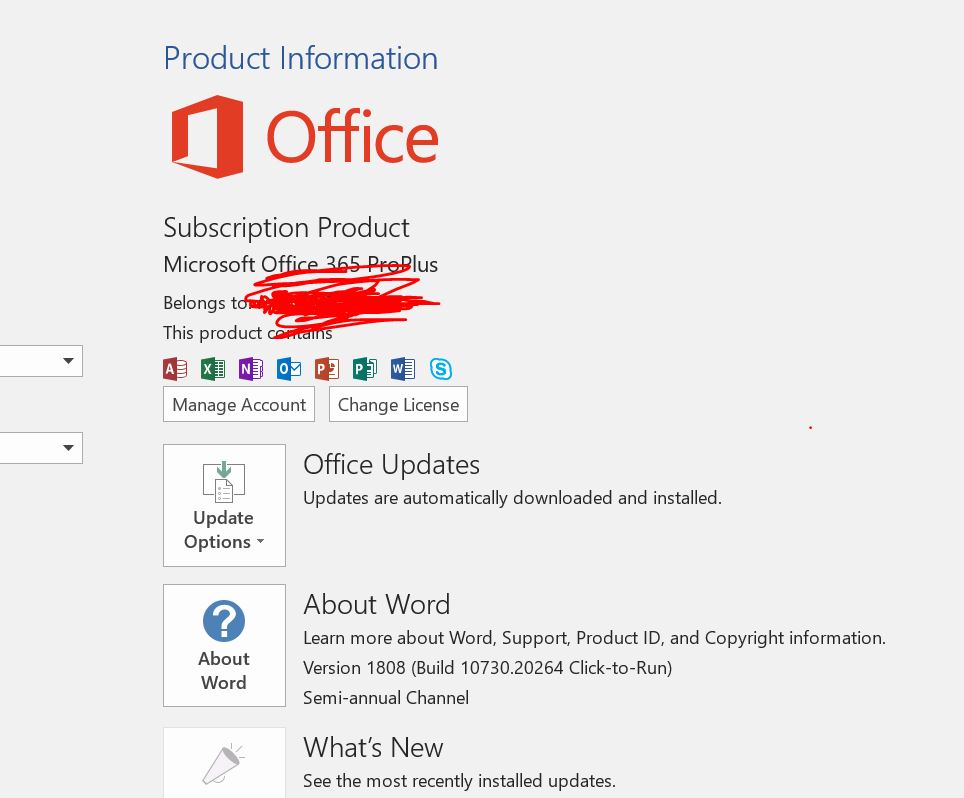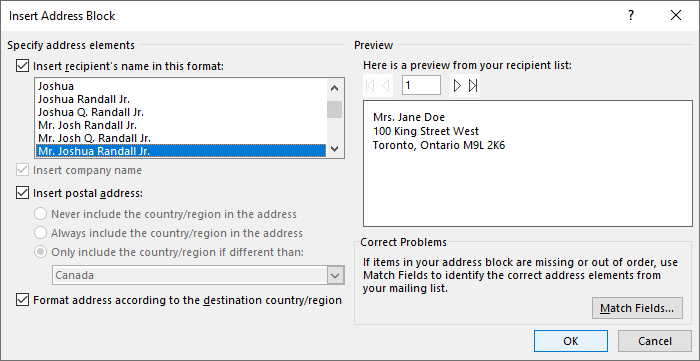To work around this problem, manually remap the Mail Merge fields so that the Courtesy Title field is mapped to the correct Mail Merge field. To do so, follow the steps in the 'How to Remap a Mail Merge Field' section in this article. To work around this problem, perform the mail merge operation from Microsoft Office Outlook 2003. If Merge to E-Mail is grayed out, it means Word doesn't think that Outlook is the default email client. I've seen two situations for this—one is addressed with that command in case Mail stubbornly keeps itself as the default email client, and the other is the corresponding Outlook version not being installed.
So this probably seems like a rather random topic for the blog but given I do write a lot about being organised, I felt this (sort of) fitted the bill. It’s something I have been struggling to work out for the last week and I couldn’t find a good guide anywhere so decided to write my own. After many moments of frustration and endless Google searching on guides for how to do a mail merge email with office for Mac I’ve finally worked it out!!
Step by step guide on how to do a mail merge email with office for Mac
First, some basic principles on mail merge emails for those who aren’t familiar. Mail merge emails are written and managed from Word, not from Outlook. All data that will be “merged” into the email is taken from an excel file. This file should be set up with headings in each column with the first column being email. So you might have columns that read Email, First Name, Surname etc. Whatever fields you have in this file are the fields you will be able to merge into your document. It is very important that you have this set up correctly with email in the FIRST column.
Let’s get started…
- Make sure your default mail setting is “Outlook”. You can co this by going to “Mail” (the Apple mailbox with the eagle on it) and selecting Preferences – General –Default Email Reader – Outlook. This is essential. It will not work if you don’t do this!
- Restart your computer (for some reason I needed to restart before it seemed to remember my preferences).
- Make sure your Excel document is set up correctly. Email should be in the first column and each other column with information will need a relevant heading. New recipients then go in each row.
- Close your Excel document.
- Open word, choose a new blank document.
- Go to Tools – Mail Merge Manager
- The Mail Merge Manager will then open. Select “Create New” and choose “Form Letters” if you want to send an email.
- In the main Word document write out your email. You can merge fields into your document here to personalise it. For example, you may want to write Dear “clients name”. You would do this by dragging the relevant placeholder into the document. It will show up as <<Column Heading>> rather than the actual contents of the column but will merge together before sending and you can preview it in a later step.
- Filter recipients using the options button. You might choose to email only certain people in your Excel document. I personally don’t use this and tend to modify my Excel file rather than filter here.
- Preview your email by clicking on the <<ABC>> button under “Preview Results”. Here you can flick through each email with the arrows and it will show you how the email will display. Keep in mind that your signature will be added by Outlook. See below for more hints on this.
- Click “Generate email messages” and Outlook will open and send your emails.
Hints & Trouble Shooting:
- Make sure the account you want to send from is your default account in Outlook.
- Outlook will automatically add your signature in but if you use a signature with an image, you may need to remove the image or set it so that it doesn’t use a signature for that account and then include your signature in the word document. I found it didn’t handle my logo well when I let Outlook insert my signature.
- If you find that the generate email messages is grayed out this is probably because you failed to restart your computer after changing your default mail reader to outlook (or you skipped this step altogether!)
- If you get an error saying “Word was unable to mail your document. Please make sure your mail program is configured correctly and that you can send mail with it” then shut down your computer and start in safe mode by holding the shift key while the computer starts. For some reason this seems to clear the caches or something and fixes the issue.
Software-as-a-Service Alternatives
If you're an organization doing a lot of targeted mailings and campaigns, you may want to consider uploading your email lists to an online service that will track campaigns and templates for you as well as give your users an easy way to unsubscribe. Here are some examples of those SaaS solutions:
Google Add-ons
There are also some third-party add-on solutions. If you don't mind the developers having access to your Google information, then you may want to explore these options:
Some other funky workarounds...

This Apple support communities discussion has some interesting other workarounds in Mac OS X for doing an email merge, including using the Mail Merge add-on for Thunderbird.


Microsoft Office (Excel, Word, Outlook) Email Merge
This blog post is really about how to do an email merge using Microsoft Office on a Mac, so here are the steps and considerations. I'm using Gmail as an example, but you can do an email merge with any kind of email account, as long as it can be put into Outlook (Exchange, POP, IMAP, etc.).

Also, please be mindful, since you don't really have an unsubscribe button in Outlook email merges, that you should still be complying with the CAN-SPAM Act guide.
So, with Gmail as an example, go to Settings.
Under Forwarding and POP/IMAP, make sure Enable IMAP is selected (you may have to scroll down a bit to see the option).
For some reason, Google doesn't consider Outlook to be secure, so in order to access Google from Outlook, you'll have to go to google.com/settings/security/lesssecureapps and select Turn on.
Launch up Outlook and select Outlook >Preferences.
Click on Accounts
Add whatever account you plan on emailing from. Since we're using a Gmail account as an example, you would click Other Email.
Enter the appropriate information, and then click Add Account.
Then click on Outlook and select Work Offline. This step isn't necessary, but I highly recommend it, because it gives you a chance to spotcheck the merged emails before they go out.
Now, launch up /Applications/Mail.app and go to Mail and select Preferences.
Unfortunately, Apple has made it so you can't select the preferences until you have set up at least one account, so you may have to set up your email account in Mail as well, even though we won't be using it.
Under Default email reader, select Microsoft Outlook.app.
If you find that Mail keeps reverting the default email client to be Mail instead of Outlook, you may have to run this command:
Make sure your Excel worksheet has at least an email column and another column (e.g., First Name). Save the Excel file some place where you can find it easily later.
Launch up Word and under Mailings, select the type to be Letters.
Why Is Mail Merge Greyed Out
Then, select Use an Existing List and find the Excel file you saved earlier.
Email Merge Is Greyed Out In Word Format
If you created the Excel sheet, you know it's not malicious. Click OK.
Click OK again, unless you're using another worksheet and have to select that.
You can insert values from different columns in the spreadsheet to be dynamic parts of your email (for example, Dear «First_Name» so the person's actual first name fills in).
When you're happy with how your 'letter' (email) looks, select Merge to E-Mail.
If Merge to E-Mail is grayed out, it means Word doesn't think that Outlook is the default email client. I've seen two situations for this—one is addressed with that command in case Mail stubbornly keeps itself as the default email client, and the other is the corresponding Outlook version not being installed. In other words, you can mix and match and use Word 2011 with Outlook 2016 as long as Outlook 2011 is installed.
Select the email address header for the To, put in the email subject you want recipients to see for Subject, and then select the message format type (probably HTML Message if you have any kind of bold/italics/color in your message).
Then click Mail Merge to Outbox.
This is where the setting-Outlook-to-offline-mode approach pays off, because you'll see your Outbox populate with the merged emails that won't send immediately.
So it means you can go into several of the pending emails and just make sure they look the way you want.
When you're satisfied with the messages, select Outlook >Work Offine to put it back online again, and then your messages should send.